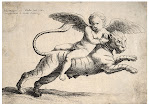
While searching for a Mary Oliver poem mentioned in a comment to Saturday's post, I came across
this recent account of a website being forced to remove Oliver's poems for copyright infringement. While there seems to be no doubt that the website owner was in violation of copyright law, she makes a persuasive case--to me anyway--that she is really operating to the benefit of the writers whose work she posts.
The whole copyright issue is something that isn't discussed much among bloggers, but it probably should be. There are precious few blogs that don't break copyright laws on a regular basis. For instance, except for images in the public domain,
all photographs or artworks are covered by copyright. You are supposed to get permission to use them. If you lift an image from a site that doesn't expressly allow sharing, you are technically breaking the law, even if you link back to the source.** I'm always amused by bloggers who go to the trouble of putting up a copyright notice to protect their original content, and then slap "stolen" images on nearly every post. (FYI, stuff at Wikimedia Commons is usually released under a Creative Commons license, which means it's fine to use it as long as you attribute it. That's why so much of the stuff on this blog comes from Wikimedia.)
I have mixed feelings about the issue. I think we should respect an artist's proprietary interest in her work. As someone who occasionally writes for money, I've felt mildly annoyed when I've seen my articles reprinted in their entirety on blogs. There's not much of a reprint market for what I do--I've sold exactly one article that way; but still, I do own the stuff, and it would be nice if the bloggers bothered to ask before making my creation their post-of-the-day. At the same time, I realize that as long as the article is properly credited, they're kinda doing me a favor. The whole point of writing the stuff is to have it read, preferably by as many people as possible.
As far as my own blogging goes, I try keep within the bounds of fair use, while realizing that I am often operating in a gray area that an author could challenge. I never print a complete poem unless it is in the public domain or I have permission.*** What I generally do is print a brief portion of a poem, and link back to a source site that does have permission. According to my reading of "fair use," that's legal for me to do on a non-commercial website, but I'm not at all sure I'd win in a court of law, especially for posts that don't have any critical content.
I will confess to posting pictures without permission and then providing a conscience-salving link, but that trick backfired on me when an attentive website owner checked out my blog and demanded that I remove both photo and link. It seems she did not wish to be associated with some of the content here. Can't imagine why. Anyway, the run-in with her pretty much cured me of the practice.
Questions about exactly what's okay and what's not are complicated by the fact that copyright laws have become increasingly restrictive, so that a work can remain under copyright for what seems like
a ridiculously long time. The other problem is that people sometimes try to claim copyright where none exists. For instance, some museum and gallery sites still try to say that
all their images are under copyright, though the
Supreme Court says otherwise.It will be interesting to see if Ms. Oliver's watchdog Googles his way to my little snippet of "Wild Geese." Of course I'll take it down if I'm ordered to, but in the meantime I'll leave it up for y'all to enjoy.
**UPDATE: I should have said that's the situation under U.S. laws. Copyright law actually varies a lot between countries. The rule may be different elsewhere.
***Oh, and looking over my poetry posts just now, I do see a couple of complete poems from the early 20th century that may not be in the public domain. So, mea culpa--I'm as guilty as everybody else.
Catullus Reading His Poem, Stepan Bakalovich, 1885. Image from
Wikimedia Commons.






















.jpg)






